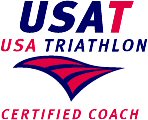Maximum Heart Rate Estimation
By USA Triathlon Coach Ken Johnson
Obviously, the best way to get your maximum heart rate is through a laboratory test. However, there are a number of ways this can be estimated in the "field":
- Classic Age Formula:
- The classic age based MHR formula is: 220 — age
- Age corrected by sex:
- Men: 220 — age
Women: 226 — age - Tanaka Method:
- Variation on age: 208 — (age * .7)
- Persons on medications:
- If you are taking medications that might affect heart rate, such as beta blockers, the formula changes to 162 — (age * .7)
- One Mile Walk Test
- Find a track and walk four continuous, evenly paced laps as fast as you can. The first three laps put you on a heart-rate plateau where you hold steady for the fourth lap.
Determine your average heart rate for this final lap.
To predict your Max HR, add 40 beats per minute if you are in poor shape, 50 bpm if you are in fair shape, and 60 bpm if you are in good shape. - The Step Test
- Use an eight-inch step. Warm up thoroughly. Then, use this four count step sequence: right foot up, left up, right down, left down. Count "up, up, down, down" as one set and keep a steady pace of 20 sets per minute.
Measure your average heart rate during the third minute, then predict your Max HR by adding 55 beats per minute if you are in poor shape, 65 bpm if you are in fair shape, and 75 bpm if you are in good shape.
One thing to remember though: estimating Maximum Heart Rate from mathematical formulas can produce results that are 10-12 beats per minute higher or lower than the actual reading. Use RPE and how you feel, along with training zones calculated from Max Heart Rate, in your training plan.
3-Fitness Triathlon Training Coach Ken's Triathlon Training at the RecPlex








